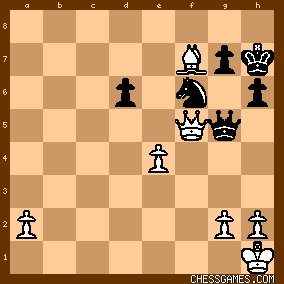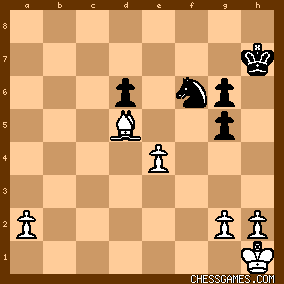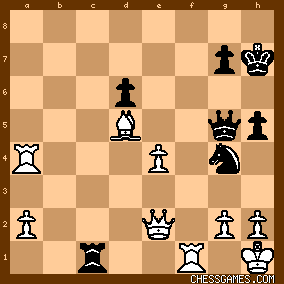Robert James Fischer
vs
James T Sherwin
"Sherwin's Forced" (game of the day Mar-09-10)
US Championship 1957/58 (1957)
·
Sicilian Defense: Najdorf Variation (B90)
· 1-0
|
|
 |
|
 |
To move: | white |
 |
Last move: | - |
|
1. e4 c5 2. Nf3 d6 3. d4 cxd4 4. Nxd4 Nf6 5. Nc3 a6 6. Bc4 e6 7. O-O b5 8. Bb3 b4 9. Nb1 Bd7 10. Be3 Nc6 11. f3 Be7 12. c3 bxc3 13. Nxc6 Bxc6 14. Nxc3 O-O 15. Rc1 Qb8 16. Nd5 exd5 17. Rxc6 dxe4 18. fxe4 Qb5 19. Rb6 Qe5 20. Bd4 Qg5 21. Qf3 Nd7 22. Rb7 Ne5 23. Qe2 Bf6 24. Kh1 a5 25. Bd5 Rac8 26. Bc3 a4 27. Ra7 Ng4 28. Rxa4 Bxc3 29. bxc3 Rxc3 30. Rxf7 Rc1 31. Qf1 h5 32. Qxc1 Qh4 33. Rxf8 Kh7 34. h3 Qg3 35. hxg4 h4 36. Be6
======================================

 |
|
< Earlier Kibitzing · PAGE 9 OF 9 ·
Later Kibitzing> |
| Jun-24-12 | | CHESSTTCAMPS:
White has a bishop for a knight, an outside passed pawn, and an
attacking focus on f7. Black also has very active pieces except for Rf8.
I remember first seeing this one from Fischer's early years a long
time ago, and recall the key move, but not the exact way the game
finished. In any case, it's critical to keep in mind the vulnerable
back ranks for both sides. 30.Rxf7!! goes directly for the target,
with the primary threat of 31.Rf5+ Kh8 32.Rxf8#. White can deal with
each of black's counters: A) 30... Rxf7? 31.Ra8+ forces mate.
B) 30... Qxd5? 31.Rxf8+ Kxf8 32.Qf1+ (protecting back rank;
of course not 32.exd5?? Rc1+) Qf7 (otherwise 33.exd5 wins) 33.Ra8+ Ke7
34.Ra7+ Ke8 35.Rxf7 wins. C) 30... Rc1+ 31.Qf1!! (A brilliant
resource! 31.Rf1+?? Kh8! 32.Ra8 [Re1 Rxe1+ 33.Qxe1 Qf4! 33.g3 Qf3+
34.Kg1 Nf2! wins] Rxa8 33.Bxa8 Qf4! wins for black) Rxf1+ 32.Rxf1+ Qxd5
33.Rxf8+ Kxf8 34.exe5 with a won endgame (R+P for a N) C.1) 31... g6 (or h6) 32.Qxc1! Qxc1 33.Rc1+ K-moves 34.Rxc1 wins a rook. C.2) 31... Qf6 32.Rxf6+ forces mate,
C.3) 31... Nf6 33.Rxf6+ Rf7 (Qxd5 34.Rxf8#) 34.Ra8+ Rc8 35.Rxc8# C.4) 31... other 32.Rxf8#
D) 30... Nf6 31.Rxf6+ Qxd5 32.Rxf8+ (exd5?? Rc1+) Kxf8 33.Qf1+ Qf7 34.Ra8+ wins as in B. E)
30... g6 31.Qf1! (Rf5+? Kg7 32.Ra7+ Kh6 and the back rank problem again
burns white) Rfc8 32.Rf5+ Kg7/h8 33.Rxg5 Rc1 34.Kg1 Ne3 35.Qxc1 Rxc1+
36.Kf2 leaves white a rook ahead. E.1) 31... Rxf7 32.Qxf7+ Kh8 33.Qg8#
F) 30... h6 31.Qf1! (Rc7+? Qxd5! 32.exd5 [Rxc3 Qe5] Rxc7)
Rxf7 32.Qxf7+ Kh7 33.Qg8+ Kg6 34.Qe8+ Kh7 (Kf6 35.Qe6#) 35.Bg8+ Kh8
36.Bf7+ Kh7 37.Qg8# Hmmm
- I see I'm missing 31... Rc1 in lines E and F. White gets 2 Rs for
the Q, but perhaps 31.Rxf8+ (followed by Qf1+ and Rf4, keeping a pawn)
is best. I've exceeded my time limit, so I'll review now. An excellent
candidate for insane.... |
 |
Jun-24-12
 | | MarkFinan: Wow!! He was 14 years old when he played this???? That Is Insane! |
 |
Jun-24-12
 | | Pawn and Two:
I had seen this game before, so it was easier for me to find 30.Rxf7!.
However, it took me a while before I found or recalled the move 31.Qf1!,
after 30.Rxf7 Rc1+. It
is interesting to analyze why 30.Bxf7+? does not give white any winning
chances. White would even lose after 30.Bxf7+? Kh8 31.Be6? Qf4! or
30...Rc1!. | |
| Jun-24-12 | | Patriot: Material is even.
30.Rxf7 Rxf7 31.Ra8+ mates in a few.
30.Rxf7 Rc1+ 31.Rf1+ Kh8 (31.Qf1 Rxf1+ 32.Rxf1+ Qxd5 33.Rxf8+ Kxf8 34.exd5  ) 32.Re1 looks like the ball is in black's court. ) 32.Re1 looks like the ball is in black's court. 30.Qxg4 Qxg4 31.Rxf7 Rc1+ 32.Rf1+ Kh8 33.Rxc1 
30.Bxf7+ Kh8 31.Be6 Rc1 looks imposing.
So it appears <30.Rxf7 Rc1+ 31.Qf1! Rxf1+ 32.Rxf1+ Qxd5 33.Rxf8+ Kxf8 34.exd5  > is key. > is key. 30...Qc1+ 31.Qf1 Nf2+ 32.Rxf2+  |
 |
Jun-24-12
 | | chrisowen: Elegant aint it good to be bombing back over these classic ones in Bobby team compute the brickd top isn't it addressing down oh the needs often the position he pierces the veil hoping to make big rookf7 stride secure the bacon and it does the nut in Rc1+ Qf1! |
 |
Jun-24-12
 | | chrisowen: Lodge the black rook appeals alive a glad welcome waste in want not dynamite in Fischer you " bim " build in mind an approach to deconstruct in weak it points here time many og hurt under Bobby spell et alia fall it in the wee hours James' back cricked maybe baby h5 cruel lame watch over sat i lead the cause too fightback starts here treble cull h5 Qxc1 Qh4 Rxf8+ kh7 h3 Qg3 hxg4. |
 |
Jun-24-12
 | | Jimfromprovidence: <Morfishine>
<However, on your comment after <30...h6>, Black is losing after <31.Rc4 Rxc4 32.Qxc4 Rxf7 33.Qc8+ Kh7 34.Bxf7>
Doesn't Black's drawing chances increase dramatically after <34...Nf6>?> Both <Dakgootje> and <Eyal> discussed the correct 35 Qf5+ response. 
click for larger viewAfter 35...g6 36 Qxg5 hxg5 37 Bd5 white’s in great shape. 
click for larger viewHe
can push his a pawn and black’s knight gets tied up to prevent its
promotion (or black gives up the knight for the pawn). As a result,
white’s bishop and king can start picking off pawns. |
 |
Jun-24-12
 | | chrisowen: <Jimfromprovidence>
Black mind to throw in the towel ask queen too many questions it ar
pluck up the courage not easy came or Bobby across from you strike the
band it is mellow yellow in appearance undulate in Qf1 the tables have
changed giving James the press in erstwhile advantage white in got d5 to
strongs a piece in uhmbrage again white ghost in low ok fry it h6 in? |
 |
Jun-24-12
 | | agb2002: A very familiar position but I'll give it a try.
White has a bishop for a knight.
The convergence of the rook on f1 and the bishop on f7 suggests 30.Rxf7, threatening 31.Rf5+: A) 30... Rc1+ 31.Qf1 (31.Rf1+ Kh8 32.Rd1 (32.Re1 Qh4) 32... Rxd1+ 33.Qxd1 Nf2+) A.1) 31... Rxf1+ 32.Rxf1+
A.1.a) 32... Kh8 33.Rxf8#.
A.1.b) 32... Qxd5 33.Rxf8+ Kxf8 34.exd5 + - [R+P vs N]. A.1.c) 32... Rf7 33.Rxf7 and Black is mated or loses the queen. A.2) 31... Nf6 32.Rxf6+ wins.
A.3) 31... h5 32.Qxc1
A.3.a) 32... Qxc1+ 33.Rf1+ Kh8 34.Rxc1 + - [N+B+P vs N]. A.3.b) 32... Qh4 33.h3 and Black's attack goes nowhere. B) 30... Qxd5 31.Rxf8+ Kxf8 32.Qf1+ Qf7 33.Ra8+ Ke7 34.Ra7+ wins. C) 30... Qc1+ 31.Qf1
C.1) 31... Qxf1+ 32.Rxf1+ Rf7 33.Ra8+ and mate next.
C.2) 31... Rxf7 32.Ra8+ Rc8 33.Qxc1 wins.
D) 30... h5 31.Rf5+ Kh7 32.Rxf8 (32.Rxg5 Rc1+) + - [R+B+P vs N]. |
 |
Jun-24-12
 | | Eyal: <D) 30... h5 31.Rf5+ Kh7 32.Rxf8 (32.Rxg5 Rc1+) + - [R+B+P vs N].> This line is actually winning for Black after 32...Rc1+ 33.Rf1: 
click for larger view33...Qf4!! with a double attack on f1 & h2.
But
it's quite instructive (just like the line 30...Rc1+ 31.Rf1+?? Kh8,
already mentioned several times) - since one of the interesting features
of this combination is that White's king position is quite perilous, so
he might easily be the one succumbing to Black's attack if he isn't
super-alert. |
 |
| Jun-24-12 | | Patriot: <agb2002> Very well done!! I didn't see the resource you found in <A)> (32.Re1 Qh4). In <A.1.c)> I think your line is winning which is "good enough". 33...Rf7 34.Ra8+ Qd8 35.Rxd8# leaves no argument. I calculated <B)> and <C> lines but didn't record it. Apparently I had forgotten those lines. I completely missed the ...h5 defense.
Good job on such an accurate analysis! |
 |
| Jun-24-12 | | Patriot: <Eyal> I think you are correct about line <D)>. But still most of his analysis is very accurate. |
 |
| Jun-24-12 | | dufferps:
I can't help wondering why Sherwin didn't play 30. ... Ne3. How would
Fisher answer that? Discovered check is spoiled by Nxd5, and meanwhile
black threatens Qxg2# |
 |
| Jun-24-12 | | LoveThatJoker: <thomasstonk:
Fischer did well, when he tried this, but the practical problems do not
indicate that the position is a correct puzzle. If "30.?" is understood
as "White moves and wins", then it has no solution, and if it is
understood as "find the best move for White", then it is not clear what
the solution will be. So, as a puzzle it is incorrect in my view.> It's
interesting that you should bring this up, as I had quite a lengthy
conversation with another notable kibitzer on this subject not too long
ago. I do agree that this puzzle is theoretically not the best
possible puzzle out there; this said, this is a game that was played at
classical time controls and therefore possesses that element of
time-pressure, and practical Chess. Yes, there is no time control
here for us CG solvers and yes the puzzle has a resource that allows
Black to play on, but the practical strength of this puzzle is inmense. Therefore
from a human/practical view it is a correct puzzle; from a theoretical
point of view, although flawed in that Black has resources that allow
him to play on, I will say that it is also a correct puzzle: If only in
that White keeps a distant passed pawn and that modern Chess engines are
finding resources for White to attempt to push on for the win. This
established, let's say that after the dust settled the engines
ultimately proved that after 30...h5 the game was a draw, I would still
say that you are wrong - or at least, not in tune with the praxis side
of Chess - in saying that this puzzle is incorrect as it a great
practical puzzle which sets a lot of difficulties on the player of the
Black pieces. LTJ |
 |
Jun-24-12
 | | Sastre: <dufferps: I can't help wondering why Sherwin didn't play 30. ... Ne3. How would Fisher answer that?> 30...Ne3 31.Qxe3 Rc1+ (31...Qxe3 32.Rf5+; 31...Rxe3 32.Rf5+) 32.Qxc1 Qxc1+ 33.Rf1+ wins. |
======================================
|

















